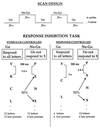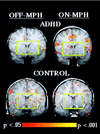Selective effects of methylphenidate in attention deficit hyperactivity disorder: a functional magnetic resonance study
- PMID: 9826728
- PMCID: PMC24401
- DOI: 10.1073/pnas.95.24.14494
Selective effects of methylphenidate in attention deficit hyperactivity disorder: a functional magnetic resonance study
Abstract
Functional MRI revealed differences between children with Attention Deficit Hyperactivity Disorder (ADHD) and healthy controls in their frontal-striatal function and its modulation by methylphenidate during response inhibition. Children performed two go/no-go tasks with and without drug. ADHD children had impaired inhibitory control on both tasks. Off-drug frontal-striatal activation during response inhibition differed between ADHD and healthy children: ADHD children had greater frontal activation on one task and reduced striatal activation on the other task. Drug effects differed between ADHD and healthy children: The drug improved response inhibition in both groups on one task and only in ADHD children on the other task. The drug modulated brain activation during response inhibition on only one task: It increased frontal activation to an equal extent in both groups. In contrast, it increased striatal activation in ADHD children but reduced it in healthy children. These results suggest that ADHD is characterized by atypical frontal-striatal function and that methylphenidate affects striatal activation differently in ADHD than in healthy children.
Figures






References
-
- Barkley R A. Attention Deficit Hyperactivity Disorder: A Handbook For Diagnosis And Treatment. New York: Guilford Press; 1990.
-
- Mannuzza S, Klein R G, Bessler A, Malloy P, Hynes M E. Am Acad Child Adolesc Psychiatry. 1997;36:1222–1227. - PubMed
-
- Swanson J M, Sergeant J A, Taylor E, Sonuga-Barke E J S, Jensen P S, Cantwell D P. Lancet. 1998;351:429–433. - PubMed
-
- Amen D G, Carmichael B D. Ann Clin Psychiatry. 1997;9:81–86. - PubMed
-
- Lou H C, Henriksen L, Bruhn P. Arch Neurol. 1984;41:825–829. - PubMed
Publication types
MeSH terms
Substances
LinkOut - more resources
Full Text Sources
Other Literature Sources
Medical

